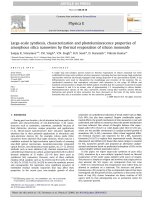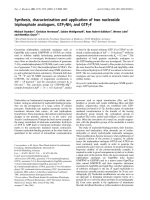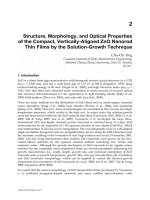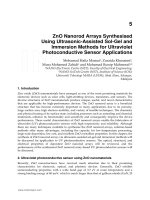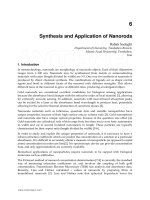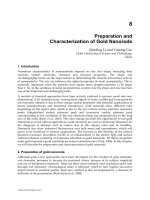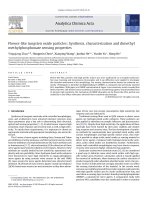ZnO nanorods synthesis, characterization and applications 31039
Bạn đang xem bản rút gọn của tài liệu. Xem và tải ngay bản đầy đủ của tài liệu tại đây (799.45 KB, 13 trang )
6
Synthesis and Application of Nanorods
Babak Sadeghi
Department of Chemistry, Tonekabon Branch,
Islamic Azad University, Tonekabon,
Iran
1. Introduction
In nanotechnology, nanorods are morphology of nanoscale objects. Each of their dimension
ranges from 1–100 nm. Nanorods may be synthesized from metals or semiconducting
materials with ratios (length divided by width) are 3-5. One way for synthesis of nanorods is
produced by direct chemical synthesis. The combinations of ligands act as shape control
agents and bond to different facets of the nanorod with different strengths. This allows
different faces of the nanorod to grow at different rates, producing an elongated object.
Gold nanorods are considered excellent candidates for biological sensing applications
because the absorbance band changes with the refractive index of local material [1], allowing
for extremely accurate sensing. In addition, nanorods with near-infrared absorption peaks
can be excited by a laser at the absorbance band wavelength to produce heat, potentially
allowing for the selective thermal destruction of cancerous tissues [2].
Nanoscale materials such as fullerenes, quantum dots and metallic nanoparticles have
unique properties, because of their high surface area to volume ratio [3]. Gold nanospheres
and nanorods also have unique optical properties, because of the quantum size effect [4].
Gold nanorods are cylindrical rods which range from less than ten to over forty nanometers
in width and up to several hundred nanometers in length. These particles are typically
characterized by their aspect ratio (length divided by width) [5-6].
In order to study and exploit the unique properties of nanorods, it is necessary to have a
robust extinction coefficient which can predict the concentration of a solution at a particular
absorbance. It is difficult to accurately obtain a measure of nanoparticle (as opposed to metal
atom) concentration in moles per liter[2]. No spectroscopic device can provide concentration
data, and only approximations are currently available.
Biomedical applications of nanoparticles require nanorods to be capped with biological
molecules such as antibodies.
The El-Sayed method of nanorod concentration determination [7-8] is currently the standard
way of measuring extinction coefficients (ε), and involves the coupling of bulk gold
concentration, Transmission Electron Microscopy (TEM) size analysis and absorbance data.
Recently, Liao and Hafner calculated ε values of nanorods by preparing films of
immobilized nanorods [2]. Liao and Hafner note that spherical byproducts lower the
www.intechopen.com
Nanorods
118
extinction coefficient calculated by the El-Sayed method, but they do not discuss the
sensitivity of ε to this kind of error.
Synthesis of gold nanorods has recently undergone dramatic improvements. It is possible to
produce high yields of nearly monodispersed short gold nanorods [6-7,9]. The rods
synthesized for this chapter were synthesized using Murphy’s method [9]. First, a “seed”
solution of spherical gold nanoparticles was prepared by adding the following:
Quantity(ml) Reagents
0.2500.01M HAuCl
4
.3H
2
O
7.5
0.1 M CTAB (cetyltrimethylammonium
bromide)
0.6 0.01 M NaBH
4
Table. 1. Preparation of Gold seed
NaBH
4
reduces the gold salt to form nanoparticles, and cetyltrimethylammonium bromide
(CTAB) ( Fig.1) is a surfactant which stabilizes the seeds to prevent aggregation. To make
nanorods, the reagents in Table.1 are added in order from top to bottom. Gold rods are
synthesized with a small amount of silver to control rod size and make short rods [7,9].
CTAB is a directing surfactant; without it, only spheres would form. CTAB forms a rod
shaped template that is filled with gold atoms as they are reduced by ascorbic acid. Ascorbic
acid is a weaker reducing agent than NaBH
4
, but in the presence of seeds and a CTAB
template, it reduces gold ions at the seed surface [6].
2. Synthesis of nanorods
General idea is the same as the growth of nanorods (seed-mediated method)
To make surfactant-coated nanorods, the well-documented seed-mediated procedure
developed by was employed. This method yields nanorods that are stabilized as verified
from transmission electron microscopy (TEM) analysis [10].
Slightly change the conditions when growing nanorods (concentration of different
reactants)
The nanorods were coated with a very thin (ca. 3-5 nm) silica film that
i. improved the colloidal stability of the nanorods by reducing aggregation,
ii. improved the shape stability of the nanorods, and
iii. allowed for further modification of the nanorod surface.
This silication method was first developed for citrate-stabilized (Fig.2.) gold NPs,[11-13] and
has been applied successfully to gold nanorods[14-19].
Cubes, hexagon, triangle, tetropods, branched
A two-step growth method has been developed to grow nanorods by changing the oxygen
content in gas mixture during nucleation and growth steps. This is based on our systematic
studies of nucleation and growth under different conditions. Due to the large lattice
mismatch (~;18%) between molecule and sapphire, the nucleation of molecule on sapphire
www.intechopen.com
Synthesis and Application of Nanorods
119
follows the three-dimensional island growth; that is, the Volmer–Weber mode, as reported
by Yamauchi et al. in their observation of plasma-assisted epitaxial growth of molecule on
sapphire [20,21]. At high temperature, the nucleation of nanorods islands on the surface of
substrates depends strongly on the amount of active oxygen. When grown entirely in 90%
oxygen plasma, nanorods has a high nucleation density and forms.
Direct chemical synthesis and a combination of ligands are all that are required for
production and shape control of the nanorods. Ligands also bond to different facets of the
nanorod with varying strengths. This is how different faces of nanorods can be made to
grow at different rates, thereby producing an elongated object of a certain desired shape.
Fig. 1. Growth mechanism of nanorods
We synthesized silver nanorods with the average length of 280 nm and diameters of around
25 nm were synthesized by a simple reduction process of silver nitrate in the presence of
polyvinyl alcohol (PVA) and investigated by means of scanning electron microscopy (SEM),
X-ray diffraction (XRD), transmission-electron microscopy (TEM).
It was found out that both temperature and reaction time are important factors in
determining the morphology and aspect ratios of nanorods (Fig.2.). TEM images showed the
prepared silver nanorods have a face centered shape (fcc) with fivefold symmetry consisting
of multiply twinned face centered cubes as revealed in the cross-section observations. The
five fold axis, i.e. the growth direction, normally goes along the (111) zone axis direction of
the basic fcc Ag-structure. Preferred crystallographic orientation along the (111), (200) or
(220) crystallographic planes and the crystallite size of the silver nanorods are briefly
analyzed [22-26].
www.intechopen.com
Nanorods
120
Fig. 2. Transmission electron microscopy (TEM) images of (a,b) individual and (c) cross
section of Ag/PVA nanorods
.
Fig. 3. (a,b,c) SEM image showing high concentrated distribution of Ag/PVA nanorods.
In our research, synthesis of silver nanorods with the controllable dimensions was described
by using a reducing agent that involves the reduction of silver nitrate with N-N'-Dimethyl
formamide (DMF) in the presence of PVA as a capping reagent. In this process the DMF is
served as both reductant and solvent [27, 28]. SEM and TEM observations (fig.2,3) along a
series of relevant directions show that the silver nanorods have an average length of 280 nm
and diameters of around 25 nm. TEM observations from cross section of nanorods show that
the transformation of silver nanospheres to silver nanorods is achieved by the oriented
attachment of several spherical particles followed by their fusion. Resulted Ag-nanorods
have a twinned fcc structure, appeared in a pentagonal shape with fivefold twinning. The
fivefold axis, i.e. the growth direction, normally goes along the (110) zone axis direction of
the fcc cubic structure. The XRD data (fig.4) confirmed that the silver nanorod is crystalline
with fcc structure with a preferred crystallographic orientation along the (220) direction and
straight, continuous, dense silver nanorod has been obtained with a diameter 25 nm. [22].
On the other hand, gold nanorods were prepared by adopting a photochemical method that
employs UV-irradiation to facilitate slow growth of rods Tetraoctylammonium bromide as a
co-surfactant used instead of tetradodecylammonium bromide. The growth solution was
prepared by dissolving 440 mg of cetyltrimethylammonium bromide (CTAB) and 4.5 mg of
a
b
c
www.intechopen.com
Synthesis and Application of Nanorods
121
tetraoctylammonium bromide (TOAB) in 15 mL of water and transferred to a cylindrical
quartz tube (length 15 cm and diameter 2 cm). To this solution, 1.25 mL of 0.024 M HAuCl
4
solution was added along with 325 µL of acetone and 225 µL of cyclohexane. The formation
of the gold nanorod and its aspect ratio was confirmed from Transmission Electron
Microscopic analysis. A drop of a dilute solution of Au nanorods was allowed to dry on a
carbon coated copper grid and then probed using a JEOL JEM-100sx electron microscope.
The average length and diameter of rods employed in the present investigation are 50.0 nm
and 20.0 nm, respectively and an average aspect ratio of 2.5 [29].
Fig. 4. XRD pattern of Ag/PVA nanocomposite indicative the face-centered cube structure.
Changes in nanorod dimensions have the greatest impact on extinction coefficients. Fig.5(a)
shows the change in the Beer’s law plot with increasing polydispersity. As variation in the
rod dimensions increases, the extinction coefficient increases. However, these increases are
not excessive – from 3.85 ± 0.07 to 4.90 ± 0.08 x 10
-8
M is not significant, and errors in
concentration resulting from this magnitude of change in ε would not be enough to cause
aggregation or substantial miscalculations of antibodies. However, the effect of spherical
www.intechopen.com
Nanorods
122
byproducts is more pronounced, and the presence of spheres can alter the extinction
coefficient enough to cause concern.
Fig. 5(b) shows that the extinction coefficient nearly doubles as percentage of spherical by
products is increased from 5% to 40%. Spherical byproducts are an ongoing challenge in
nanorods synthesis, and it is important to consider how they can change the extinction
coefficient.
a
b
Fig. 5. Effect of error as (a) polydispersity of particles change and (b) number of spherical
byproducts increases. In both cases, total gold concentration was held constant. Error bars
are very narrow.
The ranges of extinction coefficients found in this model are quite different from the values
calculated by [2] and [6], which were on the order of 109 M. However, the rods used in these
calculations, while of approximately the same aspect ratio, had dimensions of 50 x 15 nm
instead of 30 x 8 nm. The same aspect ratio implies the same peak wavelength, but can result
in a different rod volume (and thus different concentration measurements). Small changes
www.intechopen.com
Synthesis and Application of Nanorods
123
in aspect ratio can substantially change absorbance peak location [7]. Literature values must
be used cautiously in nanorod studies.
4. Application of nanorod
Nanorods have wide application.
4.1 Nanorods for dye solar cells
The dye-solar cell (DSC or Grätzel) first presented in 1991 offers an interesting paradigm
with regards the generation of electricity directly from sunlight via the photovoltaic effect.
In essence the DSC is not a definite structure but more a design philosophy to mimicking
nature in the conversion of solar energy [30]. The DCS is formed by an electrode, preferably
with a large internal surface area onto which is attached a light absorbing dye. The dye
upon absorption of a photon by photo-excitation of an electron (moving from the HOMO to
the LUMO levels) will, if in favourable conditions, inject the photo-excited electron into the
supporting structure. The dye is regenerated by a supporting Reduction & Oxidation
(REDOX) electrolyte (or hole conducting semiconductor) which permeates the working
electrode [31]. One of the many components of the DSC that can be altered is the working
electrode. General requirements are that it be porous (i.e. large internal surface area) and be
n-type semiconducting. Several metal-oxides fulfil these requirements (e.g., TiO
2
, ZnO,
WO
3
)
[32].
There are several reports describing the electrodeposition of ZnO with various conditions
explored resulting in a variety of geometries as for e.g., nanorods, nanoneedles, nanotubes,
nanoporous and compact layers [33]. In this work, a high-density vertically aligned ZnO
nanorods arrays, Fig. 6, were prepared on fluorine doped SnO
2
(FTO) coated glass
substrates, prepared at 70 ºC from a neutral zinc nitrate solution, varying the deposition
time.
Fig. 6. Cross section view of ZnO nanorod arrays electrodeposited on FTO glass
Glass
FTO
ZnO
www.intechopen.com
Nanorods
124
4.2 The use of nanorods for oligonucleotide detection
Functionalization of nanoparticles with biomolecules (antibodies, nucleic acids, etc.) is of
interest for many biomedical applications [34]. One of the most perspectives is application of
gold nanorods (GNRs) for detecting target sequences of infecting agents of many dangerous
diseases, for example, a HIV-1 [35]. The method is based on electrostatic interaction between
GNRs and DNA molecules. As single-stranded DNA molecules are zwitterions, and double-
stranded are polyanions, their affinity towards polycationic GNR stabilizer
(cetiltrimetilammoniumbromide, CTAB) is various. The GNRs plasmon-resonant [7-8] labels
are functionalized with probe single-stranded oligonucleotides by physical adsorption or by
chemical attachment. By adding complement targets to the GNRs-probe conjugate solution a
formation of aggregates is observed. It has been shown recently [35] that GNRs aggregation,
induced by DNA-DNA hybridization on their surface, can be detected by extinction and
scattering spectroscopy techniques. We have found that the characteristic parameter of
biospecific interaction is change of amplitude and differential light scattering method for
detection DNA-DNA interaction. This work is aimed at study of aggregation properties of
single-stranded probe DNA-GNRs conjugates as applied to biospecific detection of target
oligonucleotides (fig.7).
Fig. 7. Experimental diagram for oligonucleotide detection
www.intechopen.com
Synthesis and Application of Nanorods
125
Fig. 8. Schematic diagram of the surface reactions employed to obtain DNA-functionalized
gold nanorods.
In Fig.8, First the nanorods were coated with a thin silica layer using the silane coupling
agent, MPTMS, followed by reaction with sodium silicate. Surface-bound aldehyde
functional groups were attached to the silica film by using TMSA and then used to
conjugate the amine-modified DNA in a reductive amination reaction.
GNRs were produced by seed-mediated growth method in presence of CTAB. Extinction
and scattering spectra were measured in the wavelength range from 450 to 900 nanometers
which includes the transversal and longitudinal plasmon resonance [7-8] bands of GNRs.
The particle and aggregate average size were measured by the dynamic light scattering
method (DLS), and the particle shape and cluster structure were examined by transmission
electron microscopy (ТEM). 21-mer oligonucleotide complement pair was taken as a
biospecific pair, and the target sequence was related to human immunodeficiency virus-1
(HIV-1) genome. In this experiments demonstrated that reproducibility of aggregation test
depends on the GNRs synthesis protocol. In particularly, the use of protocol [36] led to
unsatisfactory results. According to TEM data, the method realization was successful while
using «dog-bone» morphology particles.
The functionalized gold nanorod synthesis can be divided into three main steps:
• Gold Nanorod Fabrication.
• Silica Shell Formation.
• DNAFunctionalization.
www.intechopen.com
Nanorods
126
4.3 The use of nanorods for applied electric field
Prominent among them is in the use in display technologies. By changing the orientation of
the nanorods with respect to an applied electric field, the reflectivity of the rods can be
altered, resulting in superior displays. Picture quality can be improved radically. Each
picture element, known as pixel, is composed of a sharp-tipped device of the scale of a few
nanometers. Such TVs, known as field emission TVs, are brighter as the pixels can glow
better in every color they take up as they pass though a small potential gap at high currents,
emitting electrons at the same time.
Nanorod-based flexible, thin-film computers can revolutionize the retail industry, enabling
customers to checkout easily without the hassles of having to pay cash.
The semiconductor nanorod structure is based on a junction between nanorod structure and
another window semiconductor layer for solar cell application. The possibility of band gap
tuning by varying the diameter of the nanorods along the length, higher absorption
coefficient at nanodimensions, the presence of a strong electrical field at the nanorod-
window semiconductor nanojunctions and the carrier confinement in lateral direction are
expected to result in enhanced absorption and collection efficiency in the proposed device.
Process steps, feasibility, technological tasks needed for the realization of the proposed
structure and the novelty of the present structure in comparison to the already reported
nanostructured solar cells are also discussed [37].
4.4 The use of nanorods for applied humidity sensitive
ZnO nanorod and nanowire films were fabricated on the Si substrates with comb type Pt
electrodes by the vapor-phase transport method, and their humidity sensitive characteristics
have been investigated. These nanomaterial films show high-humidity sensitivity, good
long-term stability and fast response time. It was found that the resistance of the films
decreases with increasing relative humidity (RH). At room temperature (RT), resistance
changes of more than four and two orders of magnitude were observed when ZnO
nanowire and nanorod devices were exposed, respectively, to a moisture pulse of 97%
relative humidity. It appears that the ZnO nanomaterial films can be used as efficient
humidity sensors [38]. The gas sensor fabricated from ZnO nanorod arrays showed a high
sensitivity to H
2
from room temperature to a maximum sensitivity at 250 °C and a detection
limit of 20 ppm. In addition, the ZnO gas sensor also exhibited excellent responses to NH
3
and CO exposure. Our results demonstrate that the hydrothermally grown vertically
aligned ZnO nanorod arrays are very promising for the fabrication of cost effective and high
performance gas sensors [39].
To use nanorods in biomedical applications, it is advised that samples are produced in bulk
and ε is calculated for each batch. In addition, Nanorod aggregation, induced by biospecific
interaction, was shown by four methods (extinction and scattering spectroscopy, DLS, TEM).
5. Conclusion
The mechanism of the nanorod formation is not yet completely understood. However, it has
now been demonstrated that the necessary requirements are at least (i) a mild reducing
agent, (ii) a protecting agent (for example consisting of a solution of PVA in DMF), and (iii)
www.intechopen.com
Synthesis and Application of Nanorods
127
the presence of metal ions in solutions. It is found that both temperature and reaction time
are important factors in determining the morphology and aspect ratios of nanorods. Lower
temperature and longer time are favorable to form polycrystalline metal nanorods with high
uniformity and aspect ratios. In addition to the nanoparticles with controllable size, silver
nanorods were successfully synthesized by converting nanoparticles at a relatively low
temperature of 80°C. We believe that the detailed investigation of silver nanorods [22] will
also help us to synthesize other metal nanorod more easily by using the similar technique.
6. Acknowledgment
The financial and encouragement support provided by the Research vice Presidency of
Tonekabon Branch, Islamic Azad University and Executive Director of Iran-Nanotechnology
Organization (Govt. of Iran).
7. References
[1] J. Pérez-Juste, I. Pastoriza-Santos, L. M. Liz-Marzàn, and P. Mulvaney. “Gold nanorods:
Synthesis, characterization and applications”, Coordination Chemistry Reviews,
vol. 249, 2005, pp. 1870-1901.
[2] H. Liao and J. H. Hafner. “Gold Nanorod Bioconjugates”. Chemistry of Materials, vol. 17,
2005, pp. 4636-4641.
[3] S. Link and M. A. El-Sayed. “Shape and size dependence of radiative, non-radiative and
photothermal properties of gold nanocrystals” International Reviews in Physical
Chemistry, vol. 19, 2000, pp. 409-453.
[4] M C. Daniel and D. Astruc. “Gold Nanoparticles: Assembly, Supramolecular Chemistry,
Quantum-Size-Regulated Properties, and Applications toward Biology, Catalysis,
and Nanotechnology” Chemical Reviews, vol. 104, 2004, pp. 293-346.
[5] C. J. Murphy and N. R. Jana. “Controlling the Aspect Ratio of Inorganic Nanorods and
Nanowires” Advanced Materials, vol. 14, 2002, pp. 80-82.
[6] C. J. Murphy, T. K. Sau, A. M. Gole, C. J. Orendorff, J. Gao, L. Gou, S. E. Hunyadi, and T.
Li. “Anisotropic Metal Nanoparticles: Synthesis, Assembly, and Optical
Applications”, Journal of Physical Chemistry B, vol. 109, 2005, pp. 13857-13870.
[7] S. Link and M. A. El-Sayed. “Spectral Properties and Relaxation Dynamics of Surface
Plasmon Electronic Oscillations in Gold and Silver Nanodots and Nanorods”,
Journal of Physical Chemistry B., vol. 103, 1999, pp. 8410-8426.
[8] B. Nikoobakht, J. Wang and M. A. Al-Sayed. “Surface-enhanced Raman scattering of
molecules adsorbed on gold nanorods: off-surface plasmon resonance condition”,
Chemical Physics Letters, vol. 366, 2002, pp. 17-23.
[9] T. K. Sau and C. J. Murphy. “Seeded High Yield Synthesis of Short Au Nanorods in
Aqueous Solution”, Langmuir, vol. 20, 2004, pp. 6414-6420.
[10] Nikoobakht, B.; El-Sayed, M. A. Chem. Mater. 2003, 15, 1957–1962.
[11] Liz-Marz_an, L. M.; Giersig, M.; Mulvaney, P. Chem. Commun. 1996, 6, 731– 732.
[12] Liz-Marz_an, L. M.; Giersig, M.; Mulvaney, P. Langmuir 1996, 12, 4329– 4335.
[13] Roca, M.; Haes, A. J. J. Am. Chem. Soc. 2008, 130, 14273–14279.
[14] Obare, S. O.; Jana, N. R.; Murphy, C. J. Nano Lett. 2001, 1, 601–603.
[15] Perez-Juste, J.; Correa-Duarte, M. A.; Liz-Marzan, L. M. Appl. Surf. Sci. 2004, 226, 137–143.
[16] Zhang, J. J.; Liu, Y. G.; Jiang, L. P.; Zhu, J. J. Electrochem. Commun. 2008, 10, 355–358.
[17] Wang, G. G.; Ma, Z. F.; Wang, T. T.; Su, Z. M. Adv. Funct. Mater. 2006, 16, 1673–1678.
www.intechopen.com
Nanorods
128
[18] Omura, N.; Uechi, I.; Yamada, S. Anal. Sci. 2009, 25, 255–259.
[19] Niidome, Y.; Honda, K.; Higashimoto, K.; Kawazumi, H.; Yamada, S.; Nakashima, N.;
Sasaki, Y.; Ishida, Y.; Kikuchi, J. Chem. Commun. 2007, 3777– 3779.
[20] S. Yamauchi, H. Handa, A. Nagayama, and T. Hariu, Thin Solid Films 345, 12 (1999).
[21] S. Yamauchi, T. Ashiga, A. Nagayama, and T. Hariu, J. Cryst. Growth 214/215, 63 (2000).
[22] M.A.S. Sadjadi, Babak Sadeghi, M. Meskinfam, K. Zare, J. Azizian. “Synthesis and
characterization of Ag/PVA nanorods by chemical reduction method” Physica E:
Low-dimensional Systems and Nanostructures, Vol.40, Issue 10,P 3183-
3186, September 2008.
[23] Babak Sadeghi, M.A.S. Sadjadi, A.Pourahmad “Effects of protective agents (PVA &
PVP) on the formation of silver nanoparticles” Internatinal journal of Nanoscience
and Nanotechnology (IJNN), Vol.4.No.1,P 3-11, December 2008.
[24] Babak Sadeghi, M.A.S.Sadjadi, R.A.R.Vahdati, "Nanoplates controlled synthesis and
catalytic activities of silver nanocrystals"Superlattices and Microstructures, Vol.46,
Issue 6, P 858-863, December 2009.
[25] Babak Sadeghi, Afshin Pourahmad, "Synthesis of silver/poly (diallyldimethylammonium
chloride) hybrid nanocomposite", Advanced Powder Technology, Vol.22, Issue.5, P
669-673, 2011.
[26] Babak Sadeghi, Sh.Ghammamy, Z.Gholipour, M.Ghorchibeigy, A.Amini Nia, "
Gold/HPC hybrid nanocomposite constructed with more complete coverage of
gold nano-shell " , Mic & Nano Letters, Vol.6, Issue 4 , P 209-213, 2011.
[27] P.K.Khanna, N.Singh, S.Charan, V.V.V.S.Subbarao, R.Gokhale, U.P.Mulik, Mater.Chem
and Phys.2005; 93:117-121.
[28] I.Pastoriza-Santoz, M.Luiz, L.Marzan, Nano lett.2002; 2:903-905.
[29] Kim, F.; Song, J. H.; Yang, P. D. J. Am. Chem. Soc. 2002, 124, 14316.
[30] B. O’Regan, M. Grätzel, Nature 335 (1991) 737;
[31] Q. Zhang, G. Cao, Nano Today 6 (2011) 91;
[32] M. Grätzel, J. Photochem. Photobiol. C: Photochem. Rev. 4 (2003) 145;
[33] O. Lupan, V. M. Guérin, I. M. Tiginyanu, V. V. Ursaki, L. Chow, H. Heinrich, T.
Pauporté, J. Photochem. Photobiol. A: Chem. 211 (2010) 65.
[34] Rosi N.L., Mirkin C.A. Nanostructures in biodiagnostics // Chem. Rev. 2005. V. 105, №
4. P. 1547–1562.
[35] He W., Huang C.Z., Li Y.F., Xie J.P., Yang R.G., Zhou P.F., Wang J. One-step label-free
optical genosensing system for sequence-specific DNA related to the human
immunodeficiency virus based on the measurements of light scattering signals of
gold nanorods // Anal. Chem. 2008. V. 80, № 22. P. 8424–8430.
[36] He W., Huang C.Z., Li Y.F., Xie J.P., Yang R.G., Zhou P.F., Wang J. One-step label-free
optical genosensing system for sequence-specific DNA related to the human
immunodeficiency virus based on the measurements of light scattering signals of
gold nanorods // Anal. Chem. 2008. V. 80, № 22. P. 8424–8430.
[37] B. R. Mehta, F. E. Kruis. A graded diameter and oriented nanorod–thin film structure
for solar cell application: a device proposal Solar Energy Materials and Solar Cells,
Volume 85, Issue 1, 1 January 2005, Pages 107-113.
[38] C.M. Chang, M.H. Hon, I.C. Leu .Preparation of ZnO nanorod arrays with tailored defect-
related characterisitcs and their effect on the ethanol gas sensing performance Sensors
and Actuators B: Chemical, Volume 151, Issue 1, 26 November 2010, Pages 15-20.[35]
Yongsheng Zhang, Ke Yu, Desheng Jiang, Ziqiang Zhu, Haoran Geng, Laiqiang Luo .
Zinc oxide nanorod and nanowire for humidity sensor. Applied Surface Science,
Volume 242, Issues 1-2, 31 March 2005, Pages 212-217.
www.intechopen.com
Nanorods
Edited by Dr. Orhan Yalçın
ISBN 978-953-51-0209-0
Hard cover, 250 pages
Publisher InTech
Published online 09, March, 2012
Published in print edition March, 2012
InTech Europe
University Campus STeP Ri
Slavka Krautzeka 83/A
51000 Rijeka, Croatia
Phone: +385 (51) 770 447
Fax: +385 (51) 686 166
www.intechopen.com
InTech China
Unit 405, Office Block, Hotel Equatorial Shanghai
No.65, Yan An Road (West), Shanghai, 200040, China
Phone: +86-21-62489820
Fax: +86-21-62489821
The book "Nanorods" is an overview of the fundamentals and applications of nanosciences and
nanotechnologies. The methods described in this book are very powerful and have practical applications in the
subjects of nanorods. The potential applications of nanorods are very attractive for bio-sensor, magneto-
electronic, plasmonic state, nano-transistor, data storage media, etc. This book is of interest to both
fundamental research such as the one conducted in Physics, Chemistry, Biology, Material Science, Medicine
etc., and also to practicing scientists, students, researchers in applied material sciences and engineers.
How to reference
In order to correctly reference this scholarly work, feel free to copy and paste the following:
Babak Sadeghi (2012). Synthesis and Application of Nanorods, Nanorods, Dr. Orhan Yalçın (Ed.), ISBN: 978-
953-51-0209-0, InTech, Available from: />of-nanorods
